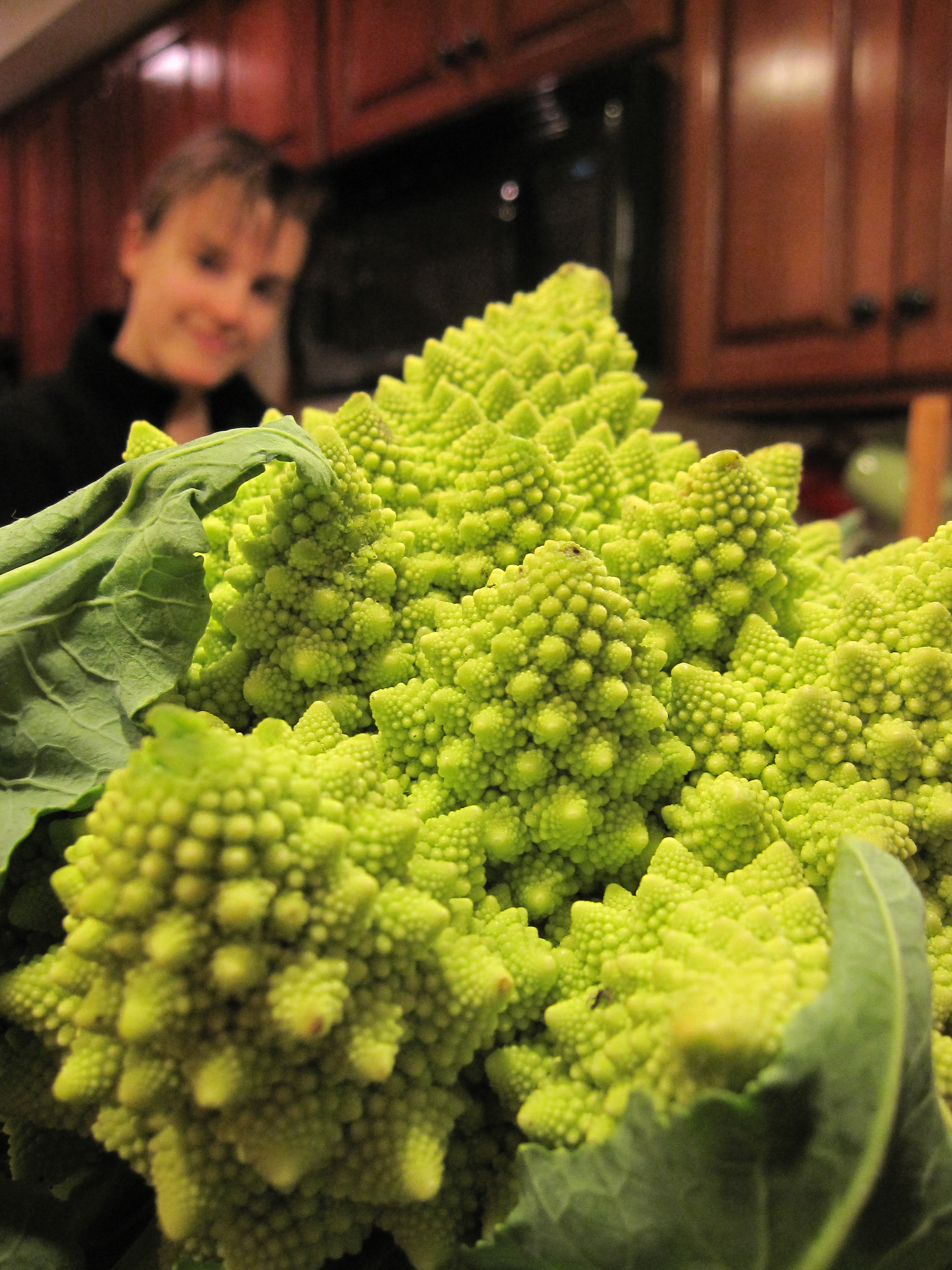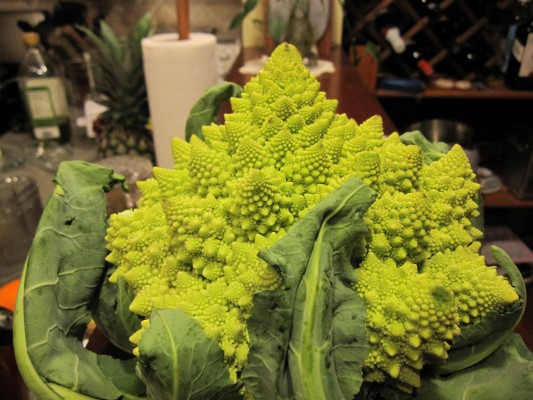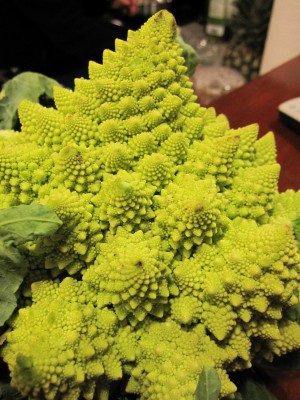I studied chaos theory and fractals in my nonlinear dynamics classes studying Fluid Mechanics in grad school. It turns out that a bunch of really cool and beautiful parts of our world behave almost randomly… but not quite: turbulence, weather, astronomy, biology, and many more. In fact the chaotic nature of fluid visualization is one of the things that attracted me most to studying fluid mechanics. I’m not the only one who appreciates it… the “Dancing Bag” scene from American Beauty is a great example.
So you can imagine how amazed and enthralled I was when Barrett brought this home!!!
This is a Romanesco Cauliflower. Its pattern resembles a Mandelbrot set which is an equation that defined a group of fractals.
So, not only was I fascinated by this foods sheer visual beauty, I was also immensely curious about its origin and nature. I immediately took about thirty pictures of it. I’m including a couple here and hope that Barrett also posts some. (You can click on the pictures to see the full size images!)
The depth of the pattern is mesmerizing. That is basically what attracts us to images of fractals. But when you see them occur in nature – well… that’s when it really blows your mind. There is some design happening in nature which creates these patterns. I for one believe it is simply the biochemical signals determined in DNA. But don’t get me wrong, in my opinion that is no less amazing than some divine power.
The other side of this beauty is the technical… turns out the mathematics of chaos isn’t really that complicated. The fundamentals are basically just arithmetic. While it might make me cross-eyed or give me math anxiety (seriously, I totally get it), I still find it amazing that such complex looking beauty can be very simple.
For example, the Mandelbrot set (which the Romanesco Cauliflower resembles) is basically defined as:
zn+1 = zn2 + c
So, if C=1, and Z0=1, then the set is: 1, 2, 5, 26, …. It turns out it’s a little more complicated than this, but not a ton more complicated – though the equations might make it seem that way.
I’ll leave you with one more image of this amazing food!
Oh… and it tasted exactly like a cauliflower. No different at all. Yummmmy!



Beautiful!
Great post. On topic: I hope you’ve heard this song, Gadi…
http://www.jonathancoulton.com/mp3/Mandelbrot%20Set.mp3
Rob,
That was great. Love how t starts with math anxiety. And in a way, it’s like the musical form of this blog post. A little art, a little history, and a little math.
And his bio is interesting:
http://en.wikipedia.org/wiki/Jonathan_coulton
Gadi
Dear Gadi:
This was an amazing lesson. I’ve glimpsed a bit of chaos theory without being intimidated. I want to know more so I am going to investigate. I am also going to try to find this amazing vegetable. I so long for more varieties of potatoes, tomatoes, and other vegetables and fruits than the ones we typically get. It is indeed awe-inspiring to see something we did not know existed and to eat it and make it part of us. Prana for sure.
I really liked yours and Barrett’s posts about this surprising-looking vegetable. Now, I’m no mathematician, let alone a fluid mechanic (!), but speaking of the surprise of beautiful mathematical structures appearing in nature, I recommend checking this out: http://www.newscientist.com/article/dn18356-most-beautiful-math-structure-appears-in-lab-for-first-time.html.
Cheers!
Ashley
Ashley, That IS interesting! I’m in your camp – physics is not my bag.
BUT, over the years, I’ve definitely had more than a few yoga teachers who are “enthralled” with quantum physics and theories about the universe. I love that yogis can “geek out” on physics, and vice versa!! We have quite a few MIT scientists in our classes in Cambridge.
Yay, and thanks for the link!
Barrett
Sometimes I sound like I’m arguing, when I’m actually not. I just have a way of putting my posts stronger than intended.
cheap herve leger dresses,
Non-Irritating AHA Lifting Peel Renew / Revitalize / Stimulate / Smooth This formula helps: ?
smooth and resurface top skin layers ? reduce appearance of fine lines, blackheads and spots ?
improve appearance of skin texture
My partner and I stumbled over here from a different
page and thought I should check things out. I like what I see so i am just following
you. Look forward to looking into your web page for a second time.